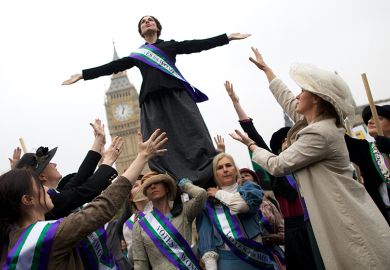It is difficult for the reader at the outset of Carla Hesse's fine series of parallel essays accurately to judge the focus or scope of her study, which, for all its scholarship and insightfulness, is not well served by its title.
She is looking at six discrete but interrelated issues surrounding women's speech and writing in the years immediately following the French revolution, and, as a result, identifying a (relatively precise) historical moment as being of seminal importance in one possible definition of modernity. When that has been grasped, the full ingenuity of her arguments and the considerable quality of her writing can emerge.
She begins by identifying and contrasting two essentially female oral phenomena - préciosité , the elevated speech of the nobility, and the poissard , or fishwives' ditty - as the dominant discourses respectively of the later 18th-century salon and the market.
Hesse then looks at the sudden explosion of published writing by women in the 1790s in a "liberalised commercial publishing world", highlighting an unsuspected diversity of genres with a full and previously unassimilated bibliography of this period. She shows how, although copyright law had taken the place of royal privilèges in 1793, a woman's intellectual property continued to accrue to her husband, leading to such social and authorial escape routes as celibacy, separation or widowhood on the one hand, and anonymity or pseudonymity on the other.
The second part of Hesse's book examines the subjects treated rather than the means of publication. It begins with the historian of Elizabeth I, Louise de Keralio-Robert, who attacked the queens of France and promoted the ideal of the domesticated republican mother, and moves on to examine the Swiss writer Isabelle de Charrière, whose novel, Trois Femmes , "explored the problem of moral duty for women in the post-revolutionary world" in terms of a tripartite critique of Kant and of sensationalism. This chapter also shows the dilemma of women writers in terms of genre, excluded as they were from academic modes of discourse, while resiting the caricature of the female novelist.
Hesse turns finally, via two major critical works of the early 19th century - Mme de Staël's De la Littérature (1800) and Mme de Genlis's De L'influence des Femmes sur la Littérature (1811) - to examine how women writers used literary fictions to engage in abstract debate. Despite the undoubted resonances of this for later writing, the sudden leap Hesse then makes to 20th-century analogies (such as Colette and Simone de Beauvoir) detracts from the tautness and elegance of her conclusion.
Nevertheless, her impressive and rigorous thesis shows how the French revolution and its aftermath "set the project of modernity into motion", not least by establishing a means for women to achieve "moral auton-omy through writing".
To what extent Simone Weil "became modern" is harder to assess, even if she did have one, apparently unpropitious, meeting with De Beauvoir. Reading Francine du Plessix Gray's balanced and accessible biography, one is constantly thrown from irritation to admiration and back again.
Weil, born into a middle-class Jewish family in Alsace in 1909, lived for a mere 34 years before dying in exile in England of tuberculosis, aggravated by anorexia nervosa. There can be few writers' lives more idiosyncratic, more disturbing and more divorced from contemporary values. Ferociously intelligent and linguistically gifted, Weil repeatedly interrupted a potentially brilliant academic career to experience the self-imposed hardships of life as a factory-worker to fight in the Spanish civil war and to seek a higher spiritual ideal in the Benedictine monastery of Solesmes. Her writings range from personal journals and letters to treatises on oppression and freedom, rights and obligations, gravity and grace.
Her earliest political commitment was to communism (her family entertained Trotsky during his visit to Paris in 1934), although she never joined the party and was later to become an uncompromising critic of Soviet Russia. Her spiritual quest was not dissimilar: although she regularly attended mass in the later stages of her life, and was baptised shortly before her death, her relations with the Roman Catholic church remained distant and, to some degree, hostile. Most strangely, it was the Jewish foundation of Christianity that proved one of the most enduring stumbling blocks, alongside her reluctance to give doctrinal assent to any one faith. For Graham Greene she stood "at the edge of the abyss, digging her feet in (and) refusing to leap like the common herd". If modernity, in Hesse's understanding of the term, is to be detected, it is in Weil's contribution to political, philosophical and religious debate and in her personal independence or in her refusal to adopt a distinct female role. But her naivety and sexual repression, her intolerance of others, her obsessive drive towards self-destruction, her adoption of extreme values - such as her wish that her parents could have been born poor, or her envy of the Crucifixion - all remind the reader of anything but modernity. On the contrary, Gray draws telling parallels between Weil's unremitting search for purity and integrity and that of the 17th-century Christian ascetic and scientist Blaise Pascal, whom Weil so admired, and with the women mystics of the later Middle Ages. Nothing encapsulates more clearly the paradox that unites Weil to such figures than Gray's comment on her "extraordinarily self-centred vocation for self-effacement".
Richard Parish is professor of French, University of Oxford.
The Other Enlightenment: How French Women Became Modern
Author - Carla Hesse
ISBN - 0 691 07472 0
Publisher - Princeton University Press
Price - £24.95
Pages - 233
Register to continue
Why register?
- Registration is free and only takes a moment
- Once registered, you can read 3 articles a month
- Sign up for our newsletter
Subscribe
Or subscribe for unlimited access to:
- Unlimited access to news, views, insights & reviews
- Digital editions
- Digital access to THE’s university and college rankings analysis
Already registered or a current subscriber?



